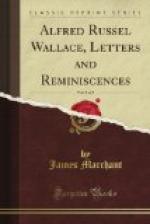value of his.
Wallace’s Eastern explorations included nearly all the large and the majority of the smaller islands of the Archipelago. Many of them he was the first naturalist to visit, or to reside on. Ceram, Batjian, Buru, Lombok, Timor, Aru, Ke and New Guinea had never been previously scientifically investigated. When in 1858 “the first and greatest of the naturalists,” as Dr. Wollaston styles Wallace, visited New Guinea, it was “the first time that any European had ventured to reside alone and practically unprotected on the mainland of this country,” which, dangerous as it is now in the same regions, was infinitely more so then. Of the journals of his voyagings, “The Malay Archipelago” will always be ranked among the greatest narratives of travel. The fact that this volume has gone through a dozen editions is witness to its extraordinary popularity among intelligent minds, and hardly supports the belief that his scientific work has been forgotten. Nor can this popularity be a matter of much surprise, for few travellers have possessed Wallace’s powers of exposition, his lucidity and charm of style. Professor Strasburger of Bonn has declared that through “The Malay Archipelago” “a new world of scientific knowledge” was unfolded before him. “I feel it ... my duty,” he adds, “to proclaim it with gratitude.” Wallace’s narrative has attracted during the past half-century numerous naturalists to follow in his tracks, many of whom have reaped rich aftermaths of his harvest; but certain it is that no explorer in the same, if in any other, region has approached his eminence, or attained the success he achieved.
As a systematic zoologist, Wallace took no inconsiderable place; his metier, however, was different. He described, nevertheless, large sections of his Lepidoptera and of his birds, on which many valuable papers are printed in the Transactions of the learned societies and in various scientific periodicals. Of the former, special mention may be made of that on variation in the “Papilionidae of the Malayan Region,” of which Darwin has recorded: “I have never in my life been more struck by any paper.” Of the latter, reference may be drawn to his account of the “Pigeons of the Malay Archipelago” and his paper on the “Passerine Birds,” in which he proposed an important new arrangement of the families of that group (used later in his “Geographical Distribution”) based on the feathering of their wings. Without a lengthy search through the zoological records, it would be impossible to say how many species Wallace added to science; but the constant recurrence in the Catalogue of Birds in the British Museum of “wallacei” as the name bestowed on various new species by other systematists, and of “Wallace” succeeding those scientifically named by himself, is an excellent gauge of their very large number.
In the field of anthropology Wallace could never be an uninterested spectator.




